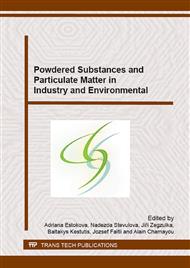p.12
p.19
p.26
p.34
p.40
p.48
p.57
p.65
p.71
Analysis of Mixing of Particulate Material by a Single Blade
Abstract:
For a correct estimation of the energy demands of particulate systems mixing it is necessary to know the stress in the particulate material situated in front of the mixing element. Despite the theoretical knowledge of the overall stress in front of the homogenizer blade, so far there is no experimental verification in the literature, due to the current absence of a suitable measuring system. This study focuses on an understanding of the distribution of the force interactions between the particulate material and the blade along its height during the mixing process. The theoretical background of this process results from the theory of equilibrium limit of the particulate material, and this state may by described by Mohrʼs circle theory. The Novosad model is the theoretical model which enables an approximate calculation of the force acting on the blade. This model takes into account the effect of the mechanical and physical properties of the particulate material. By modifying the fundamentals of the Novosad model, it will be possible to identify the force distribution along the height of the blade. For the verification of this theoretical study, a new patented measuring system was designed and implemented in the homogenizer blade.
Info:
Periodical:
Pages:
40-47
Citation:
Online since:
October 2015
Authors:
Keywords:
Price:
Сopyright:
© 2016 Trans Tech Publications Ltd. All Rights Reserved
Share:
Citation:


